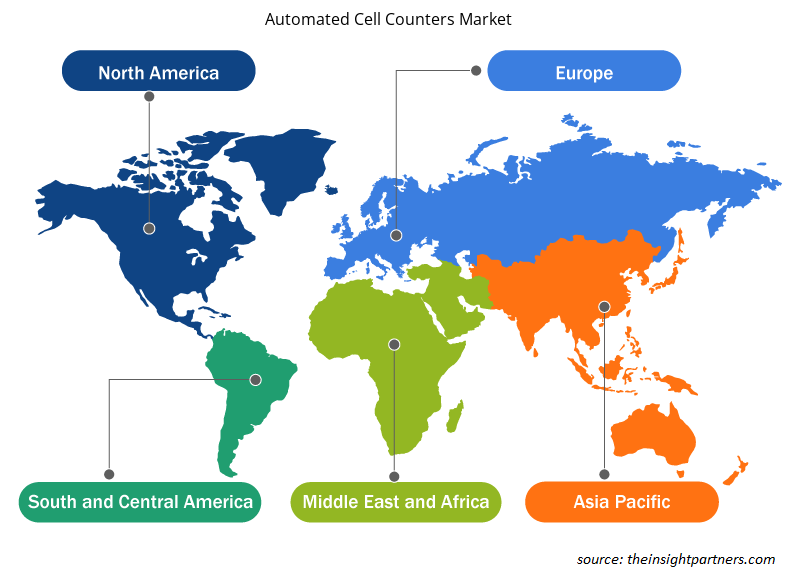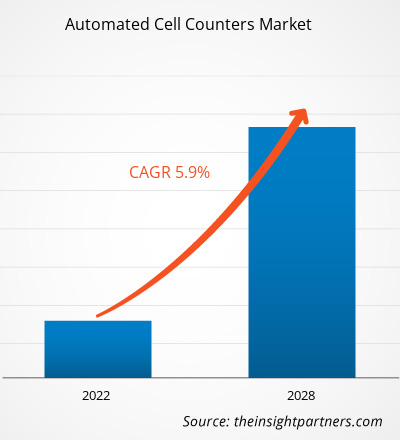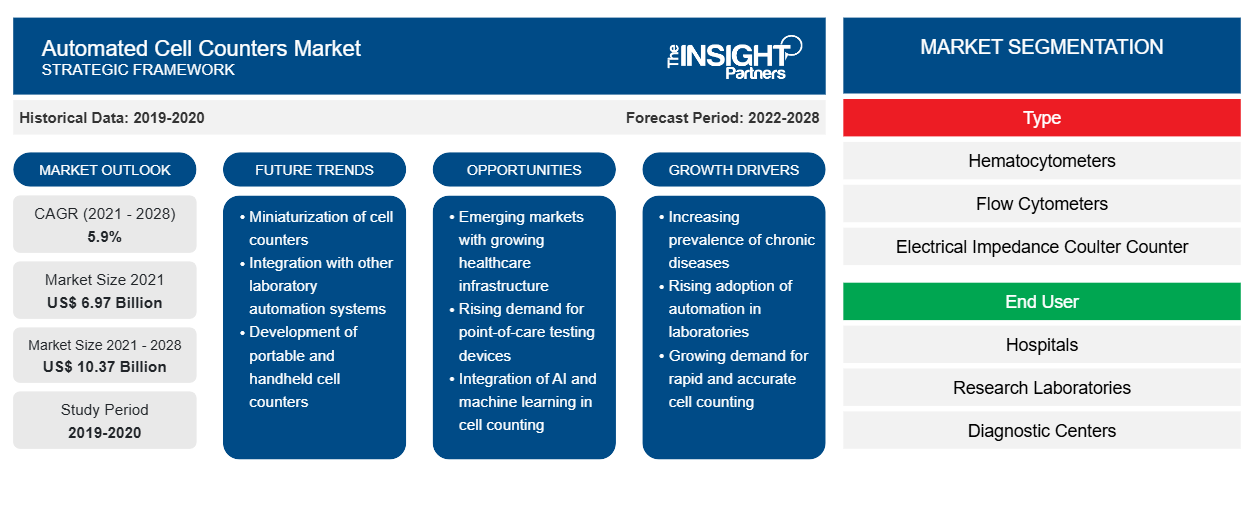من المتوقع أن ينمو سوق عدادات الخلايا الآلية من 6،974.29 مليون دولار أمريكي في عام 2021 إلى 10،365.95 مليون دولار أمريكي بحلول عام 2028؛ ومن المتوقع أن ينمو بمعدل نمو سنوي مركب قدره 5.9٪ من عام 2022 إلى عام 2028.
ويعود نمو السوق إلى ارتفاع معدل انتشار الأمراض المعدية والمزمنة.
يشتمل سوق عدادات الخلايا الآلية على لاعبين تنافسيين رئيسيين يتبنون استراتيجيات مختلفة، مثل إطلاق المنتجات والتوسع الجغرافي والتقدم التكنولوجي. فيما يلي بعض التطورات الأخيرة في السوق:
- في أبريل 2021، أعلنت شركة Eppendorf عن إطلاق منتج جديد، وهو "Centrifuge 5910 Ri"، المصمم لزيادة كفاءة المختبرات. يعد جهاز الطرد المركزي الجديد خليفة لجهاز الطرد المركزي الشهير 5910 R، وهو أحد منتجات مجموعة أجهزة الطرد المركزي متعددة الأغراض من Eppendorf التي توفر للعلماء ميزات متقدمة لتبسيط وتسريع خطوات الطرد المركزي.
- في أغسطس 2019، أعلنت شركة Agilent Technologies, Inc. عن استحواذها على شركة Biotek Instruments، وهي شركة رائدة في تصميم وتصنيع وتوزيع أجهزة العلوم الحيوية المبتكرة. ويؤدي هذا الاستحواذ إلى توسيع حضور شركة Agilent وخبرتها في تحليل الخلايا وتعزيز مكانة الشركة في مجالات المناعة السرطانية والعلاج المناعي الكبيرة والمتنامية.
- في مايو 2021، أعلنت شركة Bio-Rad Laboratories, Inc. عن شراكة مع شركات تشخيصية كبرى من خلال تقديم منتجات InteliQ، وهي مجموعة من أنابيب مراقبة الجودة التي يمكن تحميلها وشحنها. على سبيل المثال، توفر الشراكة مع Roche للعملاء إمكانية الوصول إلى مجموعة منتجات InteliQ الكاملة من Bio-Rad وحلول إدارة بيانات Unity QC وخدمات تدريب ودعم العملاء.
قم بتخصيص هذا التقرير ليناسب متطلباتك
ستحصل على تخصيص لأي تقرير - مجانًا - بما في ذلك أجزاء من هذا التقرير، أو تحليل على مستوى الدولة، وحزمة بيانات Excel، بالإضافة إلى الاستفادة من العروض والخصومات الرائعة للشركات الناشئة والجامعات
- احصل على أهم اتجاهات السوق الرئيسية لهذا التقرير.ستتضمن هذه العينة المجانية تحليلاً للبيانات، بدءًا من اتجاهات السوق وحتى التقديرات والتوقعات.
إن المشاركة النشطة من جانب اللاعبين في السوق في ابتكار وتطوير المنتجات وزيادة الموافقات على المنتجات تعمل على تغذية نمو سوق عدادات الخلايا الآلية. وعلاوة على ذلك، مع ظهور التقنيات المتقدمة، سوف ينمو السوق بشكل كبير خلال فترة التنبؤ.
وفقًا لتقرير صادر عن منظمة الصحة العالمية، هناك نقص حاد في المتخصصين في الرعاية الصحية أو العمال المدربين على استخدام معدات عداد الخلايا الآلية. البحث الجاري في مجال الأدوية والتكنولوجيا الحيوية وتطوير العديد من الأدوية لعلاج أمراض مثل السرطان واضطرابات القلب والأوعية الدموية وفيروس نقص المناعة البشرية / الإيدز، إلخ. مع التقدم التكنولوجي في عدادات الخلايا الآلية وارتفاع مجالات تطبيق الجهاز، كان هناك تحول في استخدام عدادات الخلايا الآلية. إن عمل عداد الخلايا الآلي صعب، ومعرفة هذه الأداة مهمة للغاية؛ وبالتالي، هناك طلب على قوة عاملة ماهرة. يعد تحضير العينة لمثل هذه الأدوات عملاً شاقًا، كما يجب أيضًا إدارة المواد الاستهلاكية المطلوبة أثناء الإجراء بشكل صحيح. وبالتالي، فإن الافتقار إلى قوة عاملة ماهرة يمكنها بسهولة استخدام هذه الأدوات يعيق نمو سوق عدادات الخلايا الآلية.
نظرة عامة إقليمية
سجلت منطقة آسيا والمحيط الهادئ أعلى معدل نمو سنوي مركب في سوق عدادات الخلايا الآلية في الفترة المتوقعة. يعد الطلب المرتفع على منتجات اختبار السموم والأدوية الدقيقة، وزيادة اكتشاف الأدوية، وزيادة الاستثمارات في البحث والتطوير من قبل كبار اللاعبين في السوق من بين العوامل التي تعزز نمو سوق عدادات الخلايا الآلية في منطقة آسيا والمحيط الهادئ. يتوسع سوق عدادات الخلايا الآلية في الصين بسبب زيادة عدد سكان البلاد الذين يعانون من أمراض مزمنة ومعدية . وفقًا لمنظمة الصحة العالمية، في عام 2018، أصيب حوالي 1.25 مليون شخص بفيروس نقص المناعة البشرية، وكان العدوى أكثر شيوعًا بين الشباب. وفقًا لمركز الصين لمكافحة الأمراض، تم تشخيص حوالي 400 شخص إيجابيين لفيروس نقص المناعة البشرية. علاوة على ذلك، في عام 2018، كانت هناك زيادة بنسبة 14٪ في حالات الإصابة بفيروس نقص المناعة البشرية والإيدز في الصين. يتم إجراء اختبار فيروس نقص المناعة البشرية من خلال العد المطلق للخلايا الليمفاوية بواسطة عدادات الخلايا الآلية. وبالتالي، فإن زيادة الإصابة بفيروس نقص المناعة البشرية تعزز نمو سوق عدادات الخلايا الآلية.CAGR in the automated cell counters market in the forecast period. High demand for toxicology testing products and precision medicines, increasing discovery of drugs, and rising investments in R&D by major market players are among the factors bolstering the growth of the Asia Pacific automated cell counters market. The automated cell counters market in China is expanding due to the country's increasing population suffering from chronic and
إن التطور التكنولوجي المتزايد وصناعة البحث المتنامية تجعل سوق عدادات الخلايا الآلية الصينية أكثر جاذبية. على سبيل المثال، في عام 2018، أطلقت شركة Sysmex Corporation جهاز XS-500ix، وهو جهاز تحليل دم آلي في السوق الصينية. مع النمو السكاني والاقتصادي السريع في الصين، يتزايد الطلب على الاختبارات أيضًا. لذلك، عززت الحكومة الصينية سياسات تخصيص الموارد الطبية لزيادة الكفاءة. وبالتالي، فإن هذا من شأنه أن يزيد الطلب على المنتجات المتطورة وعالية الجودة في الصين، ومن المتوقع أن يعزز نمو سوق عدادات الخلايا الآلية.Sysmex Corporation launched the XS-500ix, which is an automated Hematology Analyzer in the China market. With the rapidly growing population and economy in China, the demand for tests is also increasing. Therefore, the Chinese government has promoted policies for allocating medical resources to increase efficiency. Thus, this would increase the demand for sophisticated and high-quality products in China, which is expected to boost the market growth of automated cell counters.
وفقًا لدراسة الشيخوخة الطولية في الهند (LASI) التي أصدرتها وزارة الأسرة ورعاية الصحة في الاتحاد، 2020، يعاني اثنان من كل ثلاثة من كبار السن في الهند من أمراض مزمنة. علاوة على ذلك، يعاني حوالي 23٪ من كبار السن من حالات أمراض متعددة. أمراض القلب والأوعية الدموية هي المرض الرئيسي بين السكان فوق سن 45 عامًا. تبلغ نسبة أمراض القلب والأوعية الدموية في الفئة العمرية 45-49 عامًا 19٪، و37٪ في السكان فوق 75 عامًا. ومن المتوقع أن يكون حوالي 45٪ من العبء الإجمالي للأمراض بسبب الأمراض غير المعدية بسبب السكان المسنين المتزايدين بحلول عام 2030. وفقًا لمنظمة الصحة العالمية، يموت حوالي 5.8 مليون شخص من الأمراض غير المعدية كل عام في الهند. وبالتالي، فإن حالات الأمراض المزمنة المتزايدة بين كبار السن تدفع نمو سوق عدادات الخلايا الآلية في الهند. تنفذ حكومة الهند البرنامج الوطني للوقاية والسيطرة على السرطان والسكري وأمراض القلب والأوعية الدموية والسكتة الدماغية (NPCDS) لخلق الوعي بهذه الأمراض. ويتضمن ذلك فحص ارتفاع ضغط الدم والسكري وسرطان الفم والثدي وعنق الرحم للكشف المبكر عن الأمراض غير المعدية.Ageing Study in India (LASI) released by the Union Ministry of Family and Health Welfare, 2020, two in three senior citizens in India are suffering from chronic disease. Furthermore, ~23% of the elderly population have multi-morbidities conditions. CVD is the leading disease among the population above 45 years. The CVD percentage in the age group 45–49 years is 19%, and 37% in the population above 75 years. It is expected that ~45% of the total burden of disease due to noncommunicable will be due to the growing elderly population by 2030. According to WHO, ~5.8 million people die from noncommunicable diseases every year in India. Thus, growing chronic disease cases among the elderly population are driving the growth of the automated cell counters market in India. The government of India is implementing the National Programme for Prevention and Control of Cancer, Diabetes, Cardiovascular disease, and Stroke (NPCDS) to create awareness of these diseases. This involves screening for hypertension, diabetes, and oral, breast, and cervical cancers for the early detection of noncommunicable diseases.
وبالتالي، من المتوقع أن يؤدي ارتفاع عدد كبار السن، وحالات الأمراض المزمنة، والتدابير الرامية إلى السيطرة على الأمراض إلى تعزيز سوق عدادات الخلايا الآلية خلال الفترة المتوقعة.
رؤى النوع
بناءً على النوع، يتم تقسيم سوق عدادات الخلايا الآلية العالمية إلى عدادات خلايا الدم، ومقاييس التدفق الخلوي ، وعدادات كولتر للمعاوقة الكهربائية، وأجهزة قياس الطيف. في عام 2021، احتل قطاع أجهزة قياس الطيف أكبر حصة في السوق. على النقيض من لوحات البقع، التي يجب حضانتها لعدة أيام قبل ظهور المستعمرات، يمكن تحويل قراءات جهاز قياس الطيف على الفور إلى كثافات الخلايا. تعتمد طريقة قياس الطيف على تشتت الضوء بواسطة الخلايا في الثقافة. عندما يضرب الضوء في جهاز قياس الطيف خلية، تنحرف أشعة الضوء عن مسار مستقيم، وقد لا تصل هذه الأشعة الضوئية إلى الكاشف. كلما زاد عدد الخلايا في العينة، يحدث تشتت أخف. يعزز الطلب المتزايد على إجراءات التشخيص المبكر للكشف عن الأمراض نمو قطاع أجهزة قياس الطيف. إن الزيادة في أنشطة اكتشاف الأدوية وتطويرها بسبب زيادة الأمراض والنمو في إجراءات التشخيص السريري تدفع نمو القطاع. إن الزيادة في المبادرات الحكومية في اكتشاف وتطوير الأدوية وزيادة تطبيقات أجهزة قياس الطيف في التحليل الجزيئي الثنائي هي التي تدفع نمو هذا القطاع.hemocytometers, cytometerscoulter counters, and spectrophotometers. In 2021, the spectrophotometers segment held the largest share of the market. In contrast to spot plates, which must be incubated for several days before colonies appear, spectrophotometer readings can be instantly converted into cell densities. The spectrophotometric method is based on light scattering by the cells in the culture. When the light in a spectrophotometer hits a cell, light rays are deflected from a straight path, and these light rays may not reach the detector. The greater the number of cells in a sample, the lighter scattering occurs. The growing demand for early diagnostic procedures for the detection of diseases is boosting the growth of the spectrometers segment. A surge in drug discovery and drug development activities due to increasing diseases and growth in clinical diagnostic procedures drive the segment’s growth. An increase in government initiatives in drug discovery & development and a rise in applications of bimolecular analysis is driving the growth of the segment.
من المتوقع أن يسجل قطاع عدادات خلايا الدم أعلى معدل نمو سنوي مركب خلال فترة التنبؤ. تم تطوير عداد خلايا الدم في البداية لحساب خلايا الدم. أصبح شائعًا لحساب جميع أنواع الخلايا، بما في ذلك الكائنات الحية وحيدة الخلية مثل الخميرة والطفيليات الأولية والبكتيريا. عداد خلايا الدم هو الطريقة الأكثر فعالية من حيث التكلفة لحساب الخلايا . عداد خلايا الدم قابل لإعادة الاستخدام ويمكن استخدامه بسهولة مع أدوات شائعة أخرى في المختبر، مثل المجهر الضوئي. إن الزيادة في حدوث اضطرابات خلايا الدم التي تسبب فقر الدم والثلاسيميا والليمفوما وسرطان الدم واضطرابات أخرى هي التي تدفع نمو القطاع. على سبيل المثال، وفقًا لمنظمة الصحة العالمية، في عام 2019، بلغ معدل انتشار فقر الدم العالمي 29.9٪، أي ما يعادل أكثر من نصف مليون امرأة تتراوح أعمارهن بين 15 و 49 عامًا. علاوة على ذلك، في عام 2019، بلغ معدل انتشار فقر الدم العالمي 39.8٪ لدى الأطفال الذين تتراوح أعمارهم بين 6 و 59 شهرًا، أي ما يعادل 269 مليون طفل مصاب بفقر الدم. تُستخدم أجهزة قياس عدد خلايا الدم في البلدان النامية للكشف عن فقر الدم بسرعة وفعالية. وبالتالي، من المتوقع أن يؤدي استخدام أجهزة قياس عدد خلايا الدم للكشف عن اضطرابات الدم المختلفة إلى دفع نمو هذا القطاع من عام 2022 إلى عام 2028.
تتبنى الشركات العاملة في سوق عدادات الخلايا الآلية استراتيجية ابتكار المنتجات لتلبية متطلبات العملاء المتطورة في جميع أنحاء العالم، مما يسمح لها أيضًا بالحفاظ على اسم علامتها التجارية في السوق.
السوق العالمية لأجهزة عدادات الخلايا الآلية – التجزئة
يتم تقسيم سوق عدادات الخلايا الآلية حسب النوع والمستخدم النهائي والجغرافيا. بناءً على النوع، يتم تقسيم السوق إلى عدادات خلايا الدم، ومقاييس التدفق الخلوي، والمعاوقة الكهربائية، وأجهزة قياس الطيف الضوئي. بناءً على المستخدم النهائي، يتم تصنيف السوق إلى المستشفيات ومختبرات الأبحاث ومراكز التشخيص وغيرها. من الناحية الجغرافية، يتم تقسيم سوق عدادات الخلايا الآلية إلى أمريكا الشمالية (الولايات المتحدة وكندا والمكسيك)، وأوروبا (المملكة المتحدة وألمانيا وفرنسا وإيطاليا وإسبانيا وبقية أوروبا)، وآسيا والمحيط الهادئ (الصين واليابان والهند وأستراليا وكوريا الجنوبية وبقية آسيا والمحيط الهادئ)، والشرق الأوسط وأفريقيا (الإمارات العربية المتحدة والمملكة العربية السعودية وأفريقيا وبقية الشرق الأوسط وأفريقيا)، وأمريكا الجنوبية والوسطى (البرازيل والأرجنتين وبقية أمريكا الجنوبية والوسطى).
رؤى إقليمية حول سوق عدادات الخلايا الآلية
لقد قام المحللون في Insight Partners بشرح الاتجاهات والعوامل الإقليمية المؤثرة على سوق عدادات الخلايا الآلية طوال فترة التوقعات بشكل شامل. يناقش هذا القسم أيضًا قطاعات سوق عدادات الخلايا الآلية والجغرافيا في جميع أنحاء أمريكا الشمالية وأوروبا ومنطقة آسيا والمحيط الهادئ والشرق الأوسط وأفريقيا وأمريكا الجنوبية والوسطى.

- احصل على البيانات الإقليمية المحددة لسوق عدادات الخلايا الآلية
نطاق تقرير سوق عدادات الخلايا الآلية
| سمة التقرير | تفاصيل |
|---|---|
| حجم السوق في عام 2021 | 6.97 مليار دولار أمريكي |
| حجم السوق بحلول عام 2028 | 10.37 مليار دولار أمريكي |
| معدل النمو السنوي المركب العالمي (2021 - 2028) | 5.9% |
| البيانات التاريخية | 2019-2020 |
| فترة التنبؤ | 2022-2028 |
| القطاعات المغطاة | حسب النوع
|
| المناطق والدول المغطاة | أمريكا الشمالية
|
| قادة السوق وملفات تعريف الشركات الرئيسية |
|
كثافة اللاعبين في سوق عدادات الخلايا الآلية: فهم تأثيرها على ديناميكيات الأعمال
يشهد سوق عدادات الخلايا الآلية نموًا سريعًا، مدفوعًا بالطلب المتزايد من المستخدم النهائي بسبب عوامل مثل تفضيلات المستهلكين المتطورة والتقدم التكنولوجي والوعي المتزايد بفوائد المنتج. ومع ارتفاع الطلب، تعمل الشركات على توسيع عروضها والابتكار لتلبية احتياجات المستهلكين والاستفادة من الاتجاهات الناشئة، مما يؤدي إلى زيادة نمو السوق.
تشير كثافة اللاعبين في السوق إلى توزيع الشركات أو المؤسسات العاملة في سوق أو صناعة معينة. وهي تشير إلى عدد المنافسين (اللاعبين في السوق) الموجودين في مساحة سوق معينة نسبة إلى حجمها أو قيمتها السوقية الإجمالية.
الشركات الرئيسية العاملة في سوق عدادات الخلايا الآلية هي:
- إيبندورف
- شركة ثيرمو فيشر العلمية
- شركة كاونتستار
- مختبرات بيو راد، المحدودة
- شركة ف. هوفمان-لاروش المحدودة
إخلاء المسؤولية : الشركات المذكورة أعلاه ليست مرتبة بأي ترتيب معين.

- احصل على نظرة عامة على أهم اللاعبين الرئيسيين في سوق عدادات الخلايا الآلية
ملفات تعريف الشركة
- إيبندورف
- ثيرمو فيشر ساينتيفيك
- كاونتستار، المحدودة
- مختبرات بيو راد، المحدودة
- شركة ف. هوفمان-لاروش المحدودة
- كيموميتيك ايه/اس
- علم الوراثة المتوافق
- شركة بيكمان كولتر (داناهير)
- نانوينتيك
- شركة أوليمبوس
- ميرك كيه جي ايه ايه
- شركة سيسميكس
- شركة اجيلنت للتكنولوجيا
- أبوت
- نيكسيلوم للعلوم البيولوجية المحدودة
- التحليل التاريخي (سنتان)، سنة الأساس، التوقعات (7 سنوات) مع معدل النمو السنوي المركب
- تحليل PEST و SWOT
- حجم السوق والقيمة / الحجم - عالمي، إقليمي، بلد
- الصناعة والمنافسة
- مجموعة بيانات إكسل
التقارير الحديثة
شهادات العملاء
سبب الشراء
- اتخاذ قرارات مدروسة
- فهم ديناميكيات السوق
- تحليل المنافسة
- رؤى العملاء
- توقعات السوق
- تخفيف المخاطر
- التخطيط الاستراتيجي
- مبررات الاستثمار
- تحديد الأسواق الناشئة
- تحسين استراتيجيات التسويق
- تعزيز الكفاءة التشغيلية
- مواكبة التوجهات التنظيمية























 احصل على عينة مجانية ل - سوق عدادات الخلايا الآلية
احصل على عينة مجانية ل - سوق عدادات الخلايا الآلية